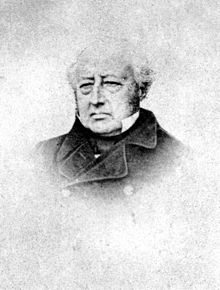Edward Bury
Edward Bury | |
|---|---|
 by Unknown 1850s | |
| Born | 22 October 1794 |
| Died | 25 November 1858 (aged 64) |
| Nationality | British |
| Occupation | Engineer |
| Engineering career | |
| Institutions | Royal Society (1844) Royal Astronomical Society Royal Historical Society Smeatonian Society of Civil Engineers Institution of Civil Engineers |
Edward Bury (22 October 1794 – 25 November 1858) was an English locomotive manufacturer. Born in Salford, Lancashire, he was the son of a timber merchant and was educated at Chester.
Career
By 1823 he was a partner in Gregson and Bury's steam sawmill at Toxteth Park, Liverpool, but in 1826 he set himself up as an iron-founder and engineer. His original premises were in Tabley Street near the Liverpool and Manchester Railway's workshops. He hoped to supply locomotives to that line, but opposition from the L&M Engineer, George Stephenson, thwarted this.
Clarence Foundry & Steam Engine Works
He moved his works to new premises in Love Lane, Liverpool, on the Leeds and Liverpool Canal and near the Clarence Dock, hence the name 'Clarence Foundry and Steam Engine Works'. Around this time he recruited as his manager James Kennedy, who had gained locomotive building experience working for George Stephenson and Mather, Dixon and Company. The first locomotive built by Edward Bury and Company, Dreadnought, was intended to compete in the Rainhill Trials, but could not be finished in time. It was a 0-6-0 and did some ballasting work on the L&MR but is said to have been objected to because it was on six wheels. It was sold to the Bolton and Leigh Railway in 1831.

Bury's second locomotive Liverpool was on four wheels, and was tried on the Liverpool & Manchester but the objection this time was to the size of the wheels, 6 feet in diameter, described as "dangerous" by George Stephenson. The wheels were reduced to 4 feet 6 inches, but this engine also went to the Bolton & Leigh. Thereafter, Bury only succeeded in selling one engine, Liver, to the Liverpool & Manchester Railway.
Liverpool combined near-horizontal inside cylinders with a multitubular boiler and a round, dome-topped firebox, mounted on a simple wrought-iron bar-frame inside the wheels, rather than wooden outside frames and inside iron sub-frames. This was a well thought-out and advanced design, which lasted. Most subsequent Bury locomotives followed this same basic design, which was copied by other firms, in Europe and the U.S.A.
London & Birmingham Railway
In 1836 Bury became the Contractor for Locomotive Power on the new London & Birmingham Railway; the railway company would provide locomotives to Bury's specification, while he would maintain them in good repair and convey each passenger at a farthing per mile, and each ton of goods at one halfpenny per mile; the passenger trains to be limited to 12 carriages and the speed not to exceed 22.5 mph. This system never worked in practice and in July 1839 the contract was annulled, and Bury became the Manager of the Locomotive Department, paid in the normal way, with a profit-linked bonus. At first he adopted a firm policy of using only 4-wheeled engines. Of the original L&BR stock of 90 engines, Bury's firm built exactly half.
Bury, Curtis and Kennedy

After taking into partnership his manager James Kennedy, together with Timothy Abraham Curtis and John Vernon, the firm was renamed Bury, Curtis and Kennedy in 1842.
London & North Western Railway
The L&BR became part of the London & North Western Railway in 1846; Bury continued as Locomotive Superintendent of the Southern Division of the L&NWR, but resigned with effect from March 1847.
Great Northern Railway
He became Locomotive Engineer on the new Great Northern Railway in February 1848 and created such a good impression that in June 1849 he was also appointed General Manager of the line. After a (possibly malicious) accusation that he had placed a small order for ironwork with a firm with which he was associated, he resigned from the G.N.R. in March 1850.
Bedford, Burys & Co
In 1852 he went into partnership in a Sheffield steelworks with Charles Cammell, and in 1855 he started another steelworks with his son, William Tarleton Bury, and John Bedford, as Bedford, Burys & Co, Regent Works, Sheffield. He had advised on the building of three railway towns, Swindon, Wolverton and Doncaster.
Honours
His engineering achievements were recognised when in 1844 he was elected a Fellow of the Royal Society. He was also a Fellow of the Royal Astronomical Society, a Fellow of the Royal Historical Society, a Member of the Smeatonian Society of Civil Engineers, and a Member of the Institution of Civil Engineers.
Family
He had married on 4 March 1830 Priscilla Susan Falkner (1799–1872), a botanist and illustrator and daughter of a wealthy Liverpool merchant. Between 1852 and 1860, Bury and his family lived at Hillsborough Hall. A plaque by the front door of the present-day building commemorates the family's residency.[1]
Death
He retired to Croft Lodge, Ambleside, but became ill in 1858 and died on 25 November at Scarborough. He was buried there.
External links
- Cork Kent Museum Edward Bury, 1794 – 1858
- The City of Sheffield Edward Bury plaque at Hillsborough Hall (now library)
References
- ^ "Hillsborough Hall : Edward Bury". flickr. Hillsborough Hall, Sheffield: The City of Sheffield. Retrieved 12 July 2016.
- Recollections of Edward Bury, by his Widow (Privately published, Windermere, 1859)
- Locomotives of the LNWR Southern Division, Harry Jack (RCTS, 2001) ISBN 0-901115-89-4
- 1794 births
- 1858 deaths
- 19th-century English people
- People of the Industrial Revolution
- English inventors
- Steam engine engineers
- British railway mechanical engineers
- British railway pioneers
- English civil engineers
- Locomotive builders and designers
- British people in rail transport
- Fellows of the Royal Society
- 19th-century British engineers
- 19th-century English businesspeople
